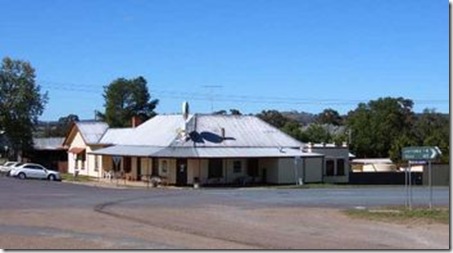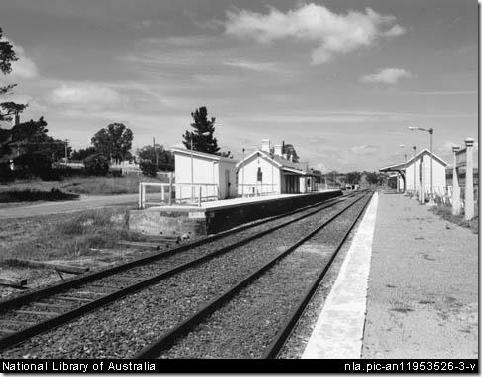My mother died in 1996. Internal evidence dates what follows to 1979, so my mother wrote it at the age of 68 at Oyster Bay while I was living in Wollongong. It is thus ten years more recent than the other memoir published here earlier. In the late 60s we had visited relatives at Wellington, Yeovil, and out towards Mudgee, some of whom had children affected by the rationalisation of the small schools. She may have also been thinking of them as she wrote.
The pages she left me have no title and consist of thirteen handwritten quarto writing pad pages. They overlap somewhat with the other memoir published here earlier. The subheadings are mine. I did not see these pages until after my mother’s death, so far as I know. The earlier memoir I had seen. Her theme in all these sketches is the worthiness of the small country schools of NSW.
The first extract dealt with Spencer, NSW, from 1906 to 1913. This page continues her story.
My father at Felled Timber Creek School (1) 1914-1915

Image from Gunning Public School site.
Just after the outbreak of World War 1 Dad was sent to a place with the lovely name of “Felled Timber Creek” which was six miles — walking — from Dalton and about twelve miles from Gunning, the nearest rail head.
Gunning Railway Station 1995 — linked to source.
I remember as a very small girl being taken from the train at some ungodly hour and then a long drive on a Cobb & Co Coach over rough roads until in the early dawn we were set down as close as the coach could take us to our new home. We trudged wearily about a mile down a bush track, and again, as at Spencer, the school was a slab built building, beside which was a mud floored slab hut which was the kitchen of the residence. The Department had out of the goodness of its heart erected a four room building of timber containing three bedrooms and a dining room, with the ever present verandah across the front where the lucky schoolie and his family were to live. The kitchen-cum-laundry — it had been used as a shearer’s hut originally — was some distance from the main house. I know it was mighty cold going from the kitchen to bed in winter when the south-west wind blew, and in the summer in that area of red clay country the heat came down as only the heat can in the real “Outback”.
Dust storm Central Western NSW — linked to source.
Dad had about 13-20 pupils at this school and those two years were a time of great trial. It was an entirely different way of life to the Hawkesbury. On the Hawkesbury there had been fish and oysters aplenty and oranges galore. Here we were in real sheep country and very much involved with very hard climatic conditions: cold winters, hot summers, and dust storms were almost a daily occurrence.
My brother and I were given the job of “going for the milk”, which meant a daily walk to our nearest neighbour about a mile away [my mother was born in 1911, and this is 1914-1915!] where an old lady in a bonnet and red flannel petticoat sat always alone in her rocking chair in the kitchen ready to give us the quart we asked for. Someone else must have milked the cows, but we never saw anyone else. [My mother mentions elsewhere that this old woman, who made quite an impression, also smoked a pipe.]
To get mail, papers, and any fresh meat or food we needed Dad had to hike the six miles to Dalton, crossing and recrossing three creeks on the way.
He still gave of his best to his pupils; they were very much harder to teach than before. Most of them came to school barefooted and often with patched pants. They were not the graziers’ children, who were sent away to boarding school at an early age, but mainly the offspring of share farmers or owners of small holdings where they worked long hours under appalling conditions for little return.
The beginning of the second year in this rather God-forsaken place my mother was again pregnant — no Pill in those days — so it was decided not to risk the hazardous journey by coach and rail to the city, so the Sister who had been present at my birth took up residence with us for five weeks before the due date of my sister’s birth and the doctor came out from Gunning. He was an Italian but quite a good medico, and he had the only car in the district — and in 1915 this was quite a vehicle. [The sister born at this time was Beth Christison (Heard) who went on to become a teacher herself. She passed away in 2007.]
About the same time as my sister arrived that terrible disease of those days, diphtheria, made its presence felt in the district and the children around literally dropped like flies. The school was closed at the request of the local Health authorities and as soon as Mum was well enough to travel, accompanied by the Nurse and a Barnardo’s girl from England who had come into our lives some two years previously to help Mother in return for a small wage and a home, we all went to Sydney where Dad was engaged at Leichhardt Primary School as an assistant teacher.
When the Health authorities cleared the Felled Timber Creek (2) school to reopen, Dad returned to a very small number of pupils indeed. Mother returned with him, plus us three children and our faithful friend. The numbers of the school did not increase — they could not — so the school was closed at the end of 1915 and Dad was appointed to Braefield, four miles from Quirindi on the North-West Plains — wheat country, this time.

Pub at Dalton NSW
 More at More tales from my mother 3 — Braefield NSW 1916-1923.
More at More tales from my mother 3 — Braefield NSW 1916-1923.
NOTES
1. Gunning Show – 11th, 1907: Goulburn Evening Penny Post, 2 March 1907.
Under the most favourable circumstances the eleventh annual show of the local P., A., and: I. Society was begun on Thursday at Gunning. Weather conditions were of the best, and the attendance for a first day was very satisfactory. The grounds were in good order, but rain appeared to be very badly needed. The Minister for Education and Colonel Ryrie, M.L.A., were amongst the visitors. A large number of school children attended from surrounding districts. The presence of the juveniles was accounted for very largely by the desire of the Department of Public Instruction to make shows to some extent training grounds for scholars. Lecturettes were given by a number of the judges, and the scholars assembled in full force under their various teachers to hear them. Mr. E. H. Turner spoke on wool, its production, and its properties; Mr. W. T. Plumb on poultry for market, breeding, and utility; and Mr. A. Lansdowne on fruit, vegetables, and farm produce. The teachers and schools represented were – Mr. W. W. Bruce, Felled Timber Creek; Mr. Campbell, Nelanglo; Mr. J. Harney, Waggallalah; Mr. A. Bundock, Chain of Ponds; Mr. P. Rocks, Gunning; Miss Lawless, St. Francis Xavier’s Convent.
In accordance with the instructions of the Education Department, a record was kept of the addresses, and the scholars will reproduce in their own way what they heard. The delivering of these short lectures and their noting add considerably to the funds of the society, as the Government will subsidise it to the extent of 2s 6d per scholar.
The show entries were far in excess of the previous year, the numbers being – 1906, 1158; 1907, 1535. Compared with the first show these figures are more formidable, as the first venture only brought forth 670 entries.
The strongest section this year was that for horses, the number of entries being 250. Sheep were also particularly well forward, and cattle showed up to far greater advantage than any previous year. So heavy was the work in these yards and so strong the competition that it was dark before the judges had come towards the end of the list. As it was some classes had to remain unjudged for the night. The prizes throughout were particularly well cut up, some going to Sydney, some to Singleton, while others were distributed in the Goulburn, Moss Vale, Gunning, and Yass districts.
The pavilion, or rather industrial hall, exhibits were better than ever before, and on every hand great admiration was expressed for the fruit display. It certainly was equal to anything shown at Goulburn, and the judge himself said that he had never seen better. Altogether in the section there were 88 distinct entries. Several non-competitive displays were made, the most attractive being exhibits by Mr. J. T. Walker, of Goulburn, and the scholars of Felled Timber Creek School. The former showed a large collection of harness, gold mounted, and made at his own establishment. The school exhibit was an excellent collection of cereals, etc., including flax fibres, flax seed, various descriptions. of wheat, barley, rye, oats, and several descriptions of chaff, all grown or prepared at the school. This display was particularly noticeable by reason of its variety and the excellence of presentation…
2. Felled Timber Creek was the birthplace of a couple of bushrangers: JOHN VANE and MICHAEL BURKE. Both were associated with the better known Johnny Gilbert and Ben Hall.

